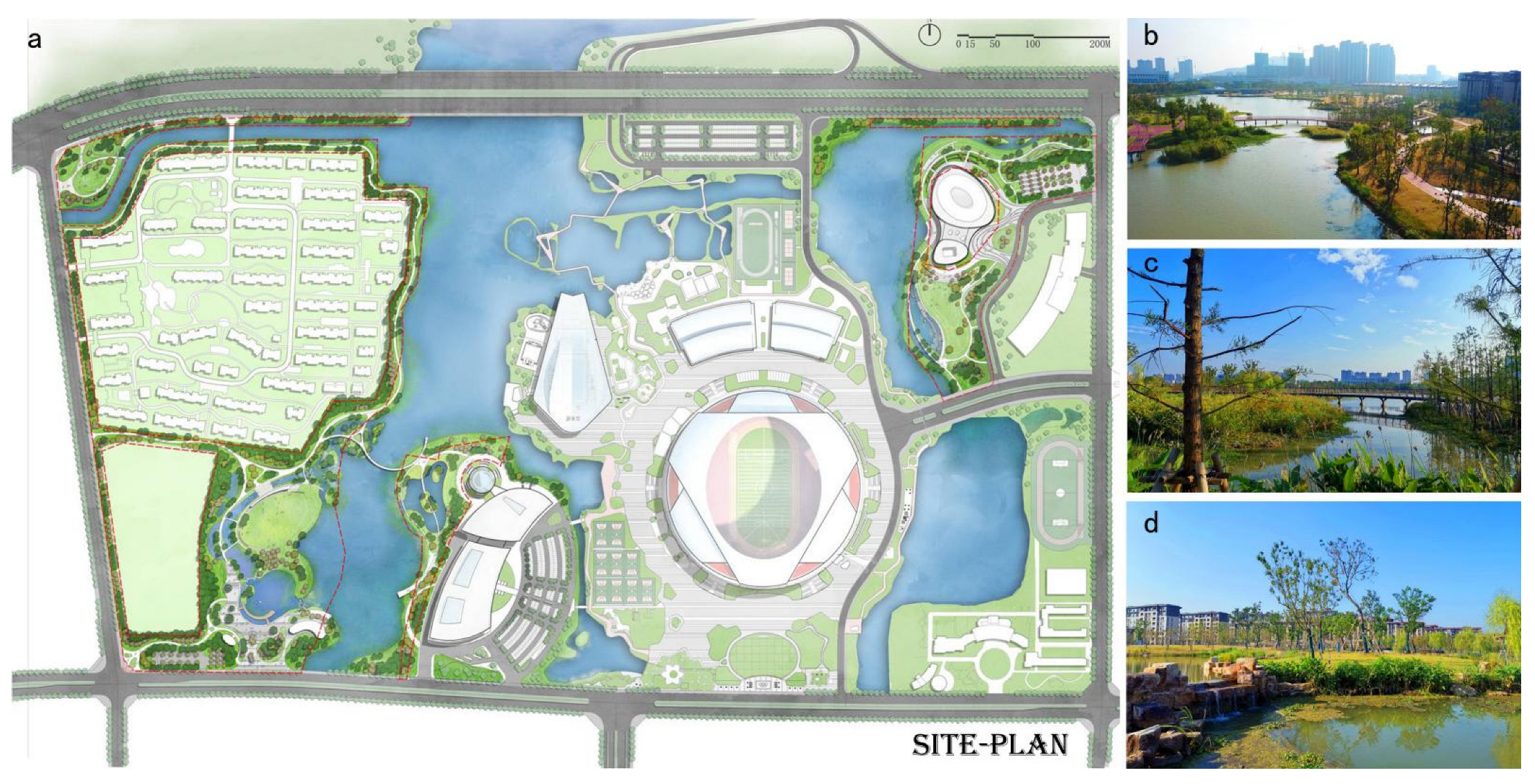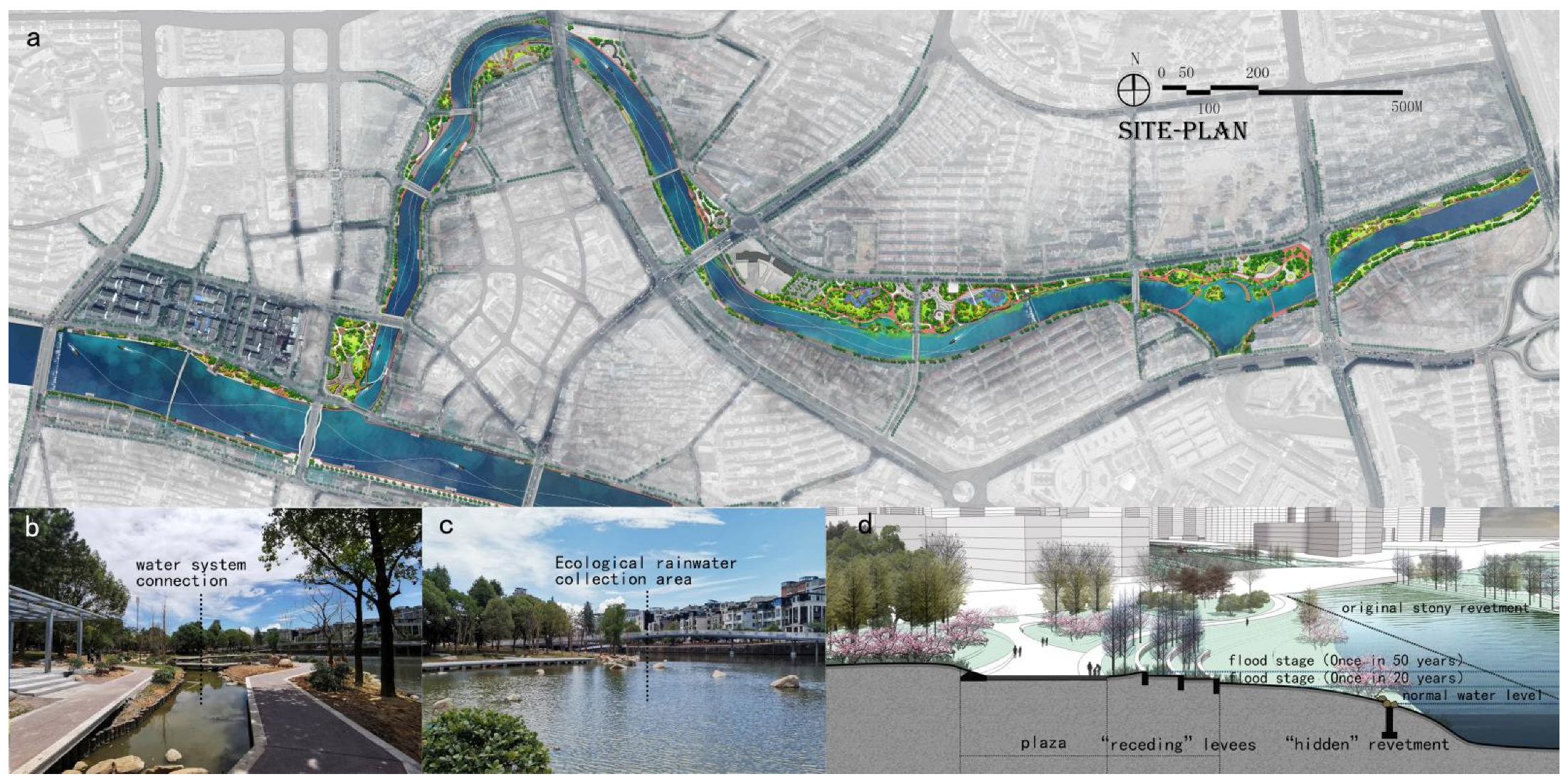Comprehensive Case Study on the Ecologically Sustainable Design of Urban Parks Based on the Sponge City Concept in the Yangtze River Delta Region of China
Abstract
:1. Introduction
1.1. Sponge City Concept
1.2. Development of the Sponge City Concept
1.3. “Failing” Sponge City Construction
2. Methods
2.1. Analysis of the Main Hydrological Characteristics of the Yangtze River Delta Region
2.1.1. Uneven Rainfall
2.1.2. High Groundwater Level
2.1.3. Low and Flat Terrain with Dense Distribution of Rivers and Lakes
2.2. Analysis Methodology
2.2.1. Multi-Objective Approach to Stormwater Management
2.2.2. Data Acquisition and Analysis
2.2.3. Organically Combined “Gray–Green” System
2.2.4. Habitat and Biodiversity
2.2.5. Sponge Construction Selection and Landscaping Treatment
3. Results and Discussion
3.1. Huzhou Olympic Park
3.2. Siyang, Changdong District, Huzhou
3.3. Yongkang Three Rivers and Six Banks Park
3.4. Yongkang Tower Hill Park
3.5. Taicang Qiputang Ecological Park
3.6. Suzhou Baiyang Lake Wetland Park Project
4. Conclusions
Author Contributions
Funding
Institutional Review Board Statement
Informed Consent Statement
Data Availability Statement
Acknowledgments
Conflicts of Interest
References
- Urban Construction Department of the Ministry of Housing and Urban-Rural Development. 2014 Work Highlights; Urban Construction Department of the Ministry of Housing and Urban-Rural Development: Beijing, China, 2014.
- Cheng, T.; Huang, B.; Yang, Z.; Qiu, J.; Zhao, B.; Xu, Z. On the effects of flood reduction for green and grey sponge city measures and their synergistic relationship—Case study in Jinan sponge city pilot area. Urban Clim. 2022, 42, 101058. [Google Scholar] [CrossRef]
- Yang, W.; Zhang, J.; Krebs, P. Low impact development practices mitigate urban flooding and non-point pollution under climate change. J. Clean. Prod. 2022, 347, 131320. [Google Scholar] [CrossRef]
- Ferrans, P.; Torres, M.N.; Temprano, J.; Rodríguez Sánchez, J.P. Sustainable Urban Drainage System (SUDS) modeling supporting decision-making: A systematic quantitative review. Sci. Total Environ. 2022, 806, 150447. [Google Scholar] [CrossRef]
- Kazemi, F.; Golzarian, M.R.; Myers, B. Potential of combined Water Sensitive Urban Design systems for salinity treatment in urban environments. J. Environ. Manag. 2018, 209, 169–175. [Google Scholar] [CrossRef] [PubMed]
- Song, C. Application of nature-based measures in China’s sponge city initiative: Current trends and perspectives. Nat.-Based Solut. 2022, 2, 100010. [Google Scholar] [CrossRef]
- Yin, D.; Chen, Y.; Jia, H.; Wang, Q.; Chen, Z.; Xu, C.; Li, Q.; Wang, W.; Yang, Y.; Fu, G.; et al. Sponge city practice in China: A review of construction, assessment, operational and maintenance. J. Clean. Prod. 2021, 280, 124963. [Google Scholar] [CrossRef]
- Meng, Y.; Wang, X.; Zhang, R. The urban wetland landscape design based on “sponge city” construction. Ecol. Econ. 2016, 32, 224–227. [Google Scholar]
- Ren, N.; Huang, H.; Wang, Q. Paradigm of sponge city construction based on regional classification. Environ. Eng. 2020, 38, 1–4. [Google Scholar]
- Fu, H. The dilemmas and countermeasures to the construction of sponge city. J. Ankang Univ. 2021, 33, 123–128. [Google Scholar]
- Zhang, B.; Yang, J.; Wu, Y.; Feng, Y. Exploration of green urban design based on multi-level water environment adaptability—Taking Xianghu area in Hangzhou as an example. Chin. Landsc. Archit. 2021, 37, 68–73. [Google Scholar]
- Zhou, H.; Li, H.; Zhao, X.; Ding, Y. Emergy ecological model for sponge cities: A case study of China. J. Clean. Prod. 2021, 296, 126530. [Google Scholar] [CrossRef]
- Wang, Y.; Cao, L.; Shen, Y. The exploration of landscape design under the background of sponge city construction—On the landscape design of the new campus of Tianjin university. Chin. Landsc. Archit. 2019, 35, 112–116. [Google Scholar]
- Yang, D.; Cao, Y.; Cao, L. Technical method and approach for structure of urban ecological stormwater management system. Chin. Landsc. Archit. 2019, 35, 24–28. [Google Scholar]
- She, N.; Xie, Y.; Li, D. Reflections and suggestions on China’s sponge city construction. Landsc. Archit. Front. 2021, 9, 82–91. [Google Scholar]
- Liu, J.; Gong, X.; Li, L.; Chen, F.; Zhang, J. Innovative design and construction of the sponge city facilities in the Chaotou Park, Talent Island, Jiangmen, China. Sustain. Cities Soc. 2021, 70, 102906. [Google Scholar] [CrossRef]
- Sun, Y.; Deng, L.; Pan, S.-Y.; Chiang, P.-C.; Sable, S.S.; Shah, K.J. Integration of green and gray infrastructures for sponge city: Water and energy nexus. Water-Energy Nexus 2020, 3, 29–40. [Google Scholar] [CrossRef]
- Wei, Z.; Wu, C. Connotation and multi-angle analysis of sponge city construction. Water Resour. Prot. 2016, 32, 19–26. [Google Scholar]
- Yuan, Y.; Zhang, Q.; Chen, S.; Li, Y. Evaluation of comprehensive benefits of sponge cities using meta-analysis in different geographical environments in China. Sci. Total Environ. 2022, 836, 155755. [Google Scholar] [CrossRef]
- Yi, Z.; Wen, W. Analysis of several major puzzles and countermeasures of sponge city construction. China Water Wastewater 2016, 32, 7–11. [Google Scholar]
- Gao, Z.; Zhang, Q.H.; Xie, Y.D.; Wang, Q.; Dzakpasu, M.; Xiong, J.Q.; Wang, X.C. A novel multi-objective optimization framework for urban green-gray infrastructure implementation under impacts of climate change. Sci. Total Environ. 2022, 825, 153954. [Google Scholar] [CrossRef]
- Leng, L.; Mao, X.; Jia, H.; Xu, T.; Chen, A.S.; Yin, D.; Fu, G. Performance assessment of coupled green-grey-blue systems for Sponge City construction. Sci. Total Environ. 2020, 728, 138608. [Google Scholar] [CrossRef] [PubMed]
- Su, D.; Zhang, Q.H.; Ngo, H.H.; Dzakpasu, M.; Guo, W.S.; Wang, X.C. Development of a water cycle management approach to Sponge City construction in Xi’an, China. Sci. Total Environ. 2019, 685, 490–496. [Google Scholar] [CrossRef] [PubMed]
- Hou, J.; Mao, H.; Li, J.; Sun, S. Spatial simulation of the ecological processes of stormwater for sponge cities. J. Environ. Manag. 2019, 232, 574–583. [Google Scholar] [CrossRef] [PubMed]
- Jiang, C.; Li, J.; Hu, Y.; Yao, Y.; Li, H. Construction of water-soil-plant system for rainfall vertical connection in the concept of sponge city: A review. J. Hydrol. 2022, 605, 127327. [Google Scholar] [CrossRef]
- Nguyen, T.T.; Ngo, H.H.; Guo, W.; Wang, X.C.; Ren, N.; Li, G.; Ding, J.; Liang, H. Implementation of a specific urban water management—Sponge City. Sci. Total Environ. 2019, 652, 147–162. [Google Scholar] [CrossRef]
- Chan, F.K.S.; Griffiths, J.A.; Higgitt, D.; Xu, S.; Zhu, F.; Tang, Y.T.; Xu, Y.; Thorne, C.R. “Sponge City” in China—A breakthrough of planning and flood risk management in the urban context. Land Use Policy 2018, 76, 772–778. [Google Scholar] [CrossRef]







| Influence Type | Influencing Factor | Key Factor Identification | Sponge City Construction Strategy and Technical Construction Recommendations |
|---|---|---|---|
| Climatic Conditions | Climate type | Subtropical monsoon climate, four distinct seasons, mild and humid climate | The primary goal is stormwater management, with an emphasis on “storage and drainage” Adapt measures to local conditions and consider other sponge city goals of “net and use” Select suitable infiltration construction according to the actual situation Focus on the coupled “gray and green” infrastructure system Adopt ecological sponge construction, such as grass-planting ditches, wet ponds, rain gardens, and ecological floating islands. |
| Rainfall | The annual precipitation is 1000–1500 mm, and the precipitation is primarily concentrated in May to August | ||
| Hydrogeology | Topography and drainage | Primarily plain, local hills, numerous lakes, the highest density of river networks in China, low-lying terrain, rich water resources | |
| Underground water level and soil | High water table, low soil permeability | ||
| Water quality | The population density is high, the amount of pollution is large, and the urban water body is more black and smelly | ||
| Others | Natural disasters | High flood risks in summer; relatively few droughts and other geological disasters |
Disclaimer/Publisher’s Note: The statements, opinions and data contained in all publications are solely those of the individual author(s) and contributor(s) and not of MDPI and/or the editor(s). MDPI and/or the editor(s) disclaim responsibility for any injury to people or property resulting from any ideas, methods, instructions or products referred to in the content. |
© 2023 by the authors. Licensee MDPI, Basel, Switzerland. This article is an open access article distributed under the terms and conditions of the Creative Commons Attribution (CC BY) license (https://creativecommons.org/licenses/by/4.0/).
Share and Cite
Ji, L.; Rao, F. Comprehensive Case Study on the Ecologically Sustainable Design of Urban Parks Based on the Sponge City Concept in the Yangtze River Delta Region of China. Sustainability 2023, 15, 4184. https://doi.org/10.3390/su15054184
Ji L, Rao F. Comprehensive Case Study on the Ecologically Sustainable Design of Urban Parks Based on the Sponge City Concept in the Yangtze River Delta Region of China. Sustainability. 2023; 15(5):4184. https://doi.org/10.3390/su15054184
Chicago/Turabian StyleJi, Lifeng, and Fei Rao. 2023. "Comprehensive Case Study on the Ecologically Sustainable Design of Urban Parks Based on the Sponge City Concept in the Yangtze River Delta Region of China" Sustainability 15, no. 5: 4184. https://doi.org/10.3390/su15054184






